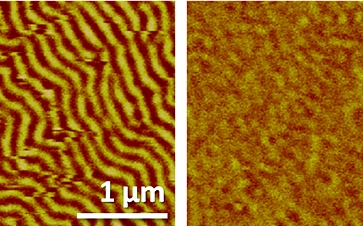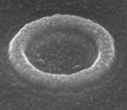New NSF Engineering Research Center to Create Chip-scale Electromagnetic Devices Enabled by Nanosystem Breakthrough

TANMS researchers have used an electric field to turn a magnetic field on (left) and off (right).
September 5, 2012
The National Science Foundation (NSF) announced today an award to the University of California Los Angeles and its partners to establish a new NSF Engineering Research Center (ERC) focused on nanoscale multiferroic devices that offer unprecedented capabilities to electromagnetic components.
The ERC, one in a cohort of three with a nanosystems focus, will pursue interdisciplinary research and education to address questions important to both nanotechnology and multiferroic-based electronics and to meet critical industry needs through innovation. NSF will invest $18.5 million in the Center over the next five years.
The NSF Nanosystems Engineering Research Center (NERC) for Translational Applications of Nanoscale Multiferroic Systems (TANMS) intends to lead the integration of newly discovered large-effect multiferroic materials into electromagnetic devices, thereby enabling chip-scale generation of magnetic fields through the simple application of a voltage. Large magnetic effects are achieved in multiferroic materials by the nanoscale design of thin-film structures, where each layer is mechanically responsive to the application of either an electric field or a magnetic field -- a combination that previously was difficult to achieve. These materials recently emerged following breakthroughs in understanding magnetic effects on the nanoscale, the development of models that coupled nanoscale effects into macroscopic component simulations, and the subsequent mastery of nanoscale manipulation to make the designer materials.
While electromagnetic devices have long been important in many communications and aerospace systems, they were difficult to miniaturize into chip-scale components, because the only way to create the magnetic component of the electromagnetic field was by setting up a current within the device. Unfortunately, the methods for current generation led to clumsy architectures that resisted scaling down to chip-size and were notorious power "hogs" that produced excessive heating. As a consequence, electromagnetic devices have not benefitted from the integrated circuit revolution that, driven by Moore's law, has led to smarter and faster electronic processors as the size of digital devices decreased. The discovery of multiferroic materials and their future integration into devices will enable electromagnetic devices to undergo a similar size transformation.
Recognizing this opportunity, this ERC aims to develop new modeling capabilities that will lead to optimized chip-scale designs for the classic electromagnetic applications in memory systems, antenna systems, and nanomotor systems. In addition, the TANMS researchers will continue to develop designer multiferroic materials and explore new application paradigms. To facilitate rapid translation of Center technology, the ERC researchers will collaborate closely with their industry partners.
The lead institution for TANMS is the University of California-Los Angeles (UCLA), which will partner extensively with California State University-Northridge, Cornell University, and the University of California-Berkeley. Researchers at the Edgenossische Technische Hochschule (ETH) in Zurich, Switzerland, will contribute additional expertise while providing international opportunities for TANMS student education.
Collaboration with more than 20 non-academic partners -- including small and large companies (particularly from aerospace, electronic components, and medical technology sectors), regional innovation organizations, and national laboratories -- will spur innovation and provide university students with first-hand experience in industrial manufacturing and entrepreneurship. The Center will also interact closely with complementary research centers and organizations specializing in technology transfer to stimulate innovation based on its research.
Since 1985, the ERC program has fostered extensive collaborations to create technological breakthroughs for new products and services and to prepare U.S. engineering graduates for successful participation in the global economy. The three centers launched this year, as part of the third generation of NSF ERCs (Gen-3 ERCs), place increased emphasis on innovation and entrepreneurship, partnerships with small research firms in translational research, education of an innovative engineering workforce, and international collaboration and cultural exchange.
The Nanosystems ERCs (NERCs) are expected to create transformational science and engineering platforms for the respective fields of nanoscale research, education, and innovation. As appropriate to its particular areas of research, each NERC will include the societal and environmental implications of the nano-enabled scientific and technological breakthroughs. The new centers are part of the National Nanotechnology Initiative (NNI), which provides a conceptual framework and additional collaborative opportunities, and they are strategically designed to build on more than a decade's worth of investment and discoveries in fundamental nanoscale science and engineering.
"This Center will bring together critical expertise in physics, materials science, and engineering to enable the integration of electromagnetic devices into chip-scale formats," said Lynn Preston, the leader of the ERC Program, "and we anticipate that, with these advances, multiferroic technologies will exhibit rapid growth."
-Cecile J. Gonzalez, NSF, cjgonzal@nsf.gov-
Media Contacts
Joshua A. Chamot, NSF, (703) 292-7730, jchamot@nsf.gov
Matthew Chin, University of California Los Angeles, (310) 206-0680, mchin@support.ucla.edu
NSF Program Contacts
Lynn Preston, NSF, (703) 292-5358, lpreston@nsf.gov
Deborah Jackson, NSF, (703) 292-7499, djackson@nsf.gov
Principal Investigator
Greg Carman, University of California Los Angeles, (310) 825-6030, carman@seas.ucla.edu
Related Websites
NSF ERC website: http://www.erc-assoc.org/
National Nanotechnology Initiative (NNI): http://nano.gov/
NNI at NSF: http://www.nsf.gov/nano
The U.S. National Science Foundation propels the nation forward by advancing fundamental research in all fields of science and engineering. NSF supports research and people by providing facilities, instruments and funding to support their ingenuity and sustain the U.S. as a global leader in research and innovation. With a fiscal year 2023 budget of $9.5 billion, NSF funds reach all 50 states through grants to nearly 2,000 colleges, universities and institutions. Each year, NSF receives more than 40,000 competitive proposals and makes about 11,000 new awards. Those awards include support for cooperative research with industry, Arctic and Antarctic research and operations, and U.S. participation in international scientific efforts.
Connect with us online
NSF website: nsf.gov
NSF News: nsf.gov/news
For News Media: nsf.gov/news/newsroom
Statistics: nsf.gov/statistics/
Awards database: nsf.gov/awardsearch/
Follow us on social
Twitter: twitter.com/NSF
Facebook: facebook.com/US.NSF
Instagram: instagram.com/nsfgov

